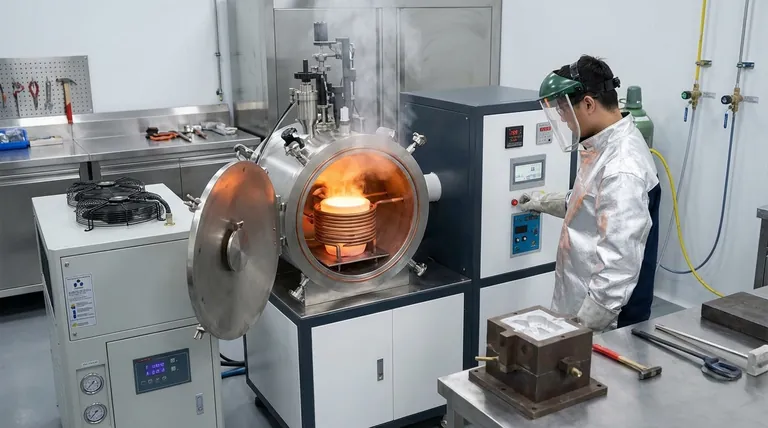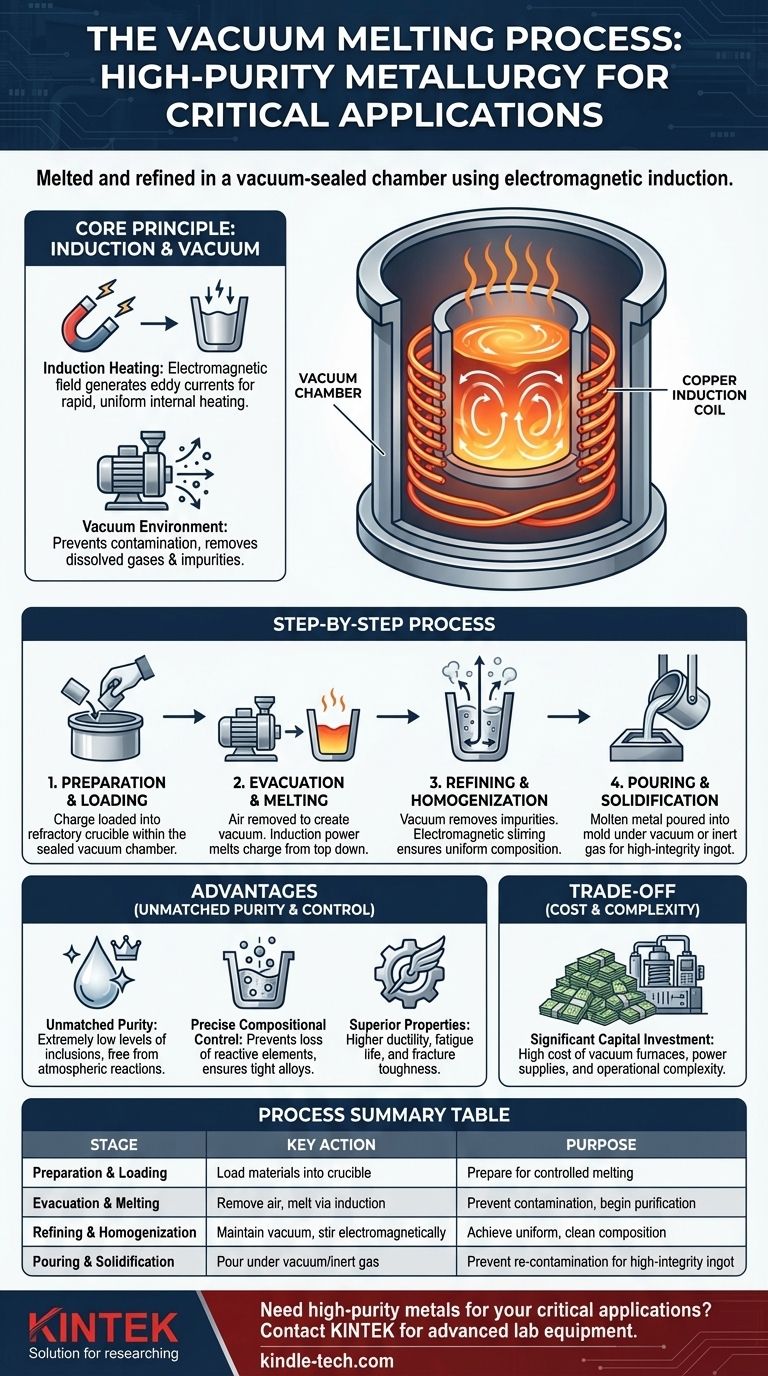In essence, vacuum melting is a metallurgical process where metals are melted and refined within a vacuum-sealed chamber. The heating is typically accomplished using electromagnetic induction, which melts the material without any direct contact, while the vacuum environment prevents contamination from atmospheric gases and actively removes impurities from the molten metal.
While standard melting techniques simply liquefy a metal, vacuum melting is a high-purity production method. Its dual purpose is to melt the charge and simultaneously refine it, resulting in ultra-clean metals and alloys with superior properties that cannot be achieved by melting in open air.

The Core Principle: Combining Induction and Vacuum
The effectiveness of vacuum melting comes from the synergistic combination of two key technologies: induction heating and a high-vacuum environment.
How Induction Heating Works
The process uses a method called electromagnetic induction. A high-frequency alternating current is passed through a water-cooled copper coil that surrounds a crucible containing the solid metal charge.
This coil acts as the primary of a transformer, and the metal charge itself becomes a short-circuited secondary. The fluctuating magnetic field induces powerful circulating eddy currents within the metal.
The metal's natural electrical resistance causes these eddy currents to generate intense heat, a phenomenon known as resistive heating. This heat builds rapidly and uniformly, melting the metal from the inside out without any flame or external heating element.
The Critical Role of the Vacuum
Melting metal in a vacuum serves two distinct and critical functions.
First, it creates a protective shield. Many high-performance alloys, such as nickel-based superalloys or those containing titanium, are highly reactive. Exposing them to oxygen and nitrogen in the air at high temperatures would form undesirable oxides and nitrides, compromising their integrity.
Second, the vacuum acts as a purifying agent. The low-pressure environment actively pulls dissolved gases, particularly hydrogen and nitrogen, out of the molten bath. It also helps vaporize and remove other impurities with high vapor pressures, resulting in a cleaner, more refined final product.
A Step-by-Step Breakdown of the Process
The Vacuum Induction Melting (VIM) process is a precise, multi-stage operation designed for maximum control and purity.
Stage 1: Preparation and Loading
The process begins with the careful selection and preparation of the raw materials, or "charge," to meet the target alloy composition. This charge is loaded into a refractory crucible, typically made of ceramic or graphite, which is then placed inside the vacuum chamber.
Stage 2: Evacuation and Melting
Once the chamber is sealed, powerful pumps remove the air to achieve a specified vacuum level. Only then is power applied to the induction coil.
The charge begins to melt, often from the top down. This layered melting is advantageous as it allows trapped gases to escape easily as the liquid-solid interface moves downward.
Stage 3: Refining and Homogenization
After the entire charge is molten, it enters the refining stage. The vacuum is maintained to continue drawing out dissolved gases and volatile elements.
Simultaneously, the electromagnetic field that heats the metal also induces a constant, gentle stirring motion in the molten bath. This electromagnetic stirring is crucial for ensuring the alloy becomes perfectly homogenous, with all elements равномерно distributed.
Stage 4: Pouring and Solidification
Once the metal reaches the desired temperature and chemical composition, it is poured into a mold to create an ingot or a near-net-shape casting. In most high-purity operations, this pouring step is also performed under vacuum or in an inert-gas atmosphere to prevent any re-contamination before solidification.
Understanding the Trade-offs and Advantages
Vacuum melting is not a universal solution. Its use is dictated by a clear set of advantages and a primary trade-off.
Advantage: Unmatched Purity
By preventing reactions with air and actively removing dissolved gases and volatile impurities, VIM produces metals and alloys with exceptionally low levels of inclusions.
Advantage: Precise Compositional Control
The vacuum environment prevents the loss of reactive alloying elements to oxidation. Combined with electromagnetic stirring, this allows for the production of alloys with extremely tight and accurate chemical compositions.
Advantage: Superior Material Properties
The resulting cleanliness and homogeneity translate directly to improved mechanical properties. Vacuum-melted materials exhibit higher ductility, superior fatigue life, and greater fracture toughness, making them essential for high-stress, critical applications.
The Trade-off: Cost and Complexity
The primary drawback of vacuum melting is its cost. Vacuum furnaces, high-power supplies, and pumping systems represent a significant capital investment. The process is also more complex and slower than air melting, leading to higher operational costs.
Making the Right Choice for Your Goal
Deciding whether to use a vacuum-melted material is a strategic choice based on the demands of the final application.
- If your primary focus is extreme performance and reliability: Specify vacuum-melted materials for critical components in aerospace, medical implants, or power generation turbines where failure is not an option.
- If your primary focus is creating alloys with reactive elements: VIM is the necessary method for producing alloys based on titanium, nickel, cobalt, and other elements that would be contaminated by air.
- If your primary focus is cost-sensitive, general-purpose applications: A conventional and less expensive air-melting process is almost always a more appropriate and economical choice.
Ultimately, specifying a vacuum-melted material is a decision to prioritize metallurgical purity and predictable performance over lower initial cost.
Summary Table:
| Process Stage | Key Action | Purpose |
|---|---|---|
| 1. Preparation & Loading | Load raw materials into a crucible inside a sealed chamber. | Prepare the alloy charge for melting in a controlled environment. |
| 2. Evacuation & Melting | Remove air to create a vacuum; melt metal via induction heating. | Prevent contamination and begin the purification process. |
| 3. Refining & Homogenization | Maintain vacuum to remove dissolved gases; stir molten metal electromagnetically. | Achieve a uniform, clean chemical composition. |
| 4. Pouring & Solidification | Pour molten metal into a mold under vacuum or inert gas. | Prevent re-contamination during solidification for a high-integrity ingot. |
Need high-purity metals for your critical applications?
Vacuum melting is essential for producing the ultra-clean alloys required in aerospace, medical implant, and power generation industries. At KINTEK, we specialize in advanced lab equipment and consumables that support these high-stakes manufacturing processes.
Our expertise can help you achieve the superior material properties and precise compositional control your projects demand. Contact us today to discuss how our solutions can enhance your lab's capabilities and ensure the reliability of your materials.
Get in touch with our experts now!
Visual Guide

Related Products
- Lab-Scale Vacuum Induction Melting Furnace
- Vacuum Heat Treat Furnace and Levitation Induction Melting Furnace
- Vacuum Arc Induction Melting Furnace
- 600T Vacuum Induction Hot Press Furnace for Heat Treat and Sintering
- Vacuum Heat Treat Sintering Brazing Furnace
People Also Ask
- What are the advantages of vacuum induction melting? Achieve Ultimate Purity & Precision for High-Performance Alloys
- What are the advantages of induction melting? Achieve Faster, Cleaner, and More Controlled Metal Melting
- What is the principle of vacuum induction melting? Achieve Ultra-High Purity Metals
- What is VIM in metallurgy? A Guide to Vacuum Induction Melting for High-Performance Alloys
- What is vacuum induction melting used for? Creating Ultra-Pure Metals for Demanding Industries



















